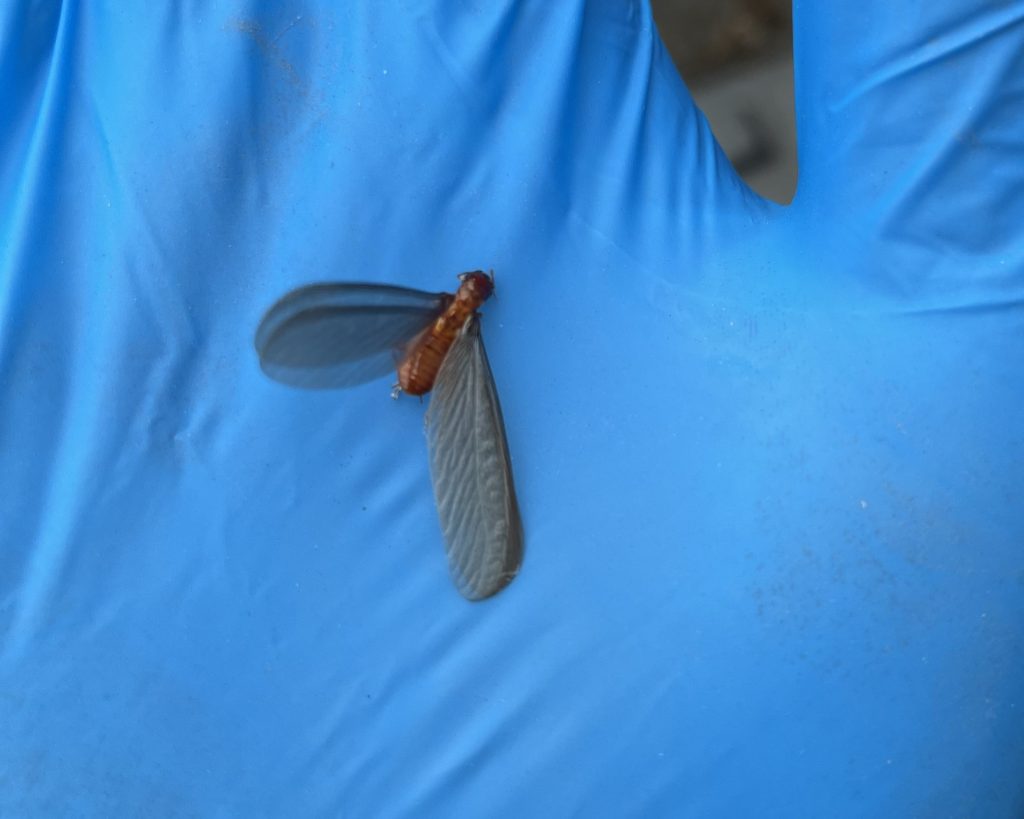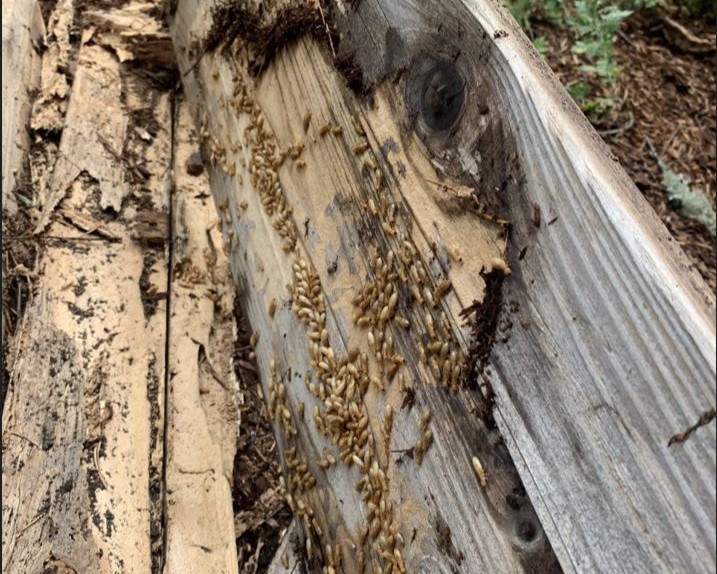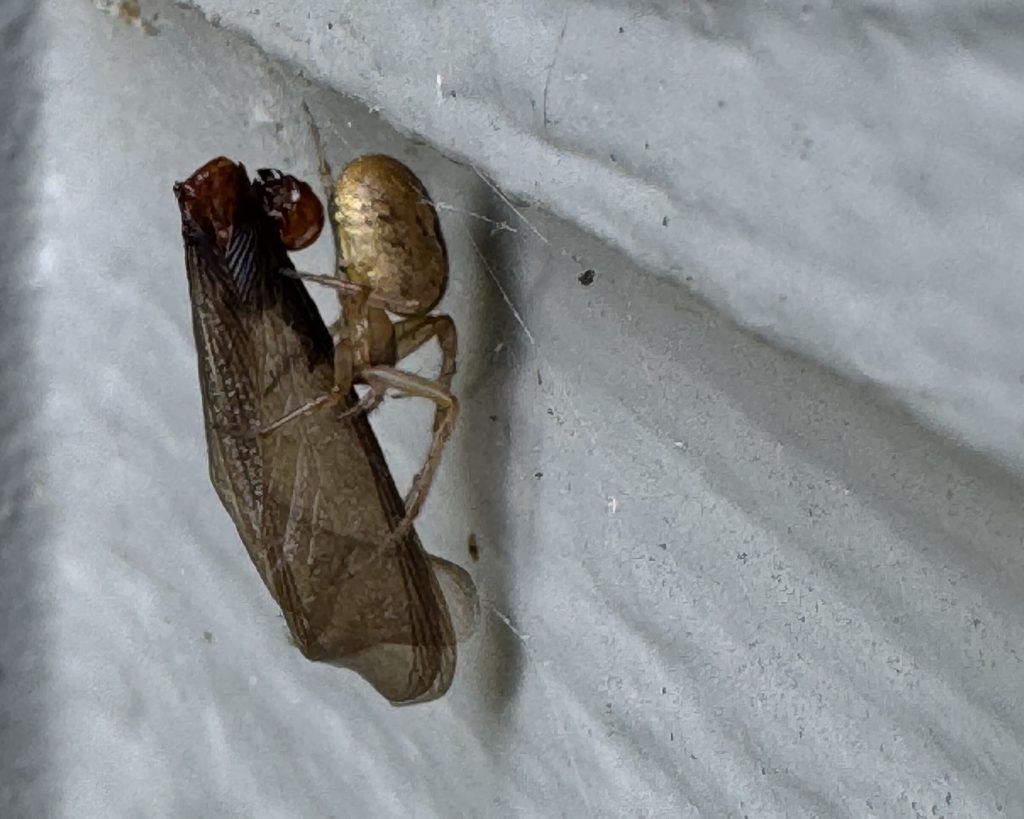Every year, as if on cue, large, winged termites make their dramatic appearance in and around homes, fluttering about and sending homeowners into a tizzy. While the sight of termites—any termites—can trigger instant dread, it’s important to understand that these big termites are a bit different.
What you are seeing is most likely the Dampwood Termite.
But fear not! Unlike their more destructive relatives, these dampwood termites aren’t looking to make your home their next meal, unless you’ve got specific conditions they can’t resist. Let’s demystify these seasonal visitors and explain why you might not need to worry after all.
Before we go any further, make sure you are actually dealing with winged termites and not winged Carpenter Ants! For more information on winged Carpenter Ants, check out the article written by our Technical Director Adam “The ACE” Hiddleson!
Key Takeaways:
- Identify Dampwood Termites: Learn how to recognize these specific termites.
- Assessing Your Risk: Evaluate how your home’s condition influences potential infestations.
- Preventative Steps: Simple measures to ensure your home remains unattractive to these pests.
- When to Seek Help: Knowing when it’s time to call in the professionals.
Understanding Dampwood Termites
Dampwood termites are significantly less threatening to structurally sound homes than their infamous counterparts like subterranean or drywood termites. These termites thrive in very moist environments and are typically attracted to wood that is already in decay due to moisture problems. They are larger than other termites, a trait that helps in quickly identifying them during a swarm.
Dampwood Colony Structure
Dampwood termites, like other termites, live in highly structured colonies that are organized based on a caste system. At the heart of this system is the queen, whose primary role is to reproduce and ensure the growth of the colony. The king stays alongside the queen for life, aiding in reproduction. Surrounding them are the workers and soldiers. The workers are responsible for foraging, feeding other members of the colony, and caring for the young, while the soldiers protect the colony from threats. Unlike other termite species, dampwood termites do not have a true worker caste; instead, immature termites (nymphs) perform these roles until they mature. This unique aspect of their social structure allows for a more flexible division of labor within the colony.
These swarming dampwood termites, also known as alates, that you might be seeing fluttering about are the reproductive members of the colony. They play a critical role in the survival and expansion of their species. These winged termites emerge from the colony en masse during specific seasons, typically in late summer or early fall, depending on environmental conditions.
The purpose of this mass emergence, known as swarming, is for swarmers to find mates and establish new colonies. After swarming, male and female alates pair up, shed their wings, and begin the process of reproducing and forming a new colony. The successful establishment of a new colony hinges on the ability of these alates to locate an environment with ample moisture and decaying wood, where they can thrive and repeat the life cycle.

A dampwood termite swarmer held by a Good Earth Pest Company technician, highlighting the termite’s size and appearance.
How to Identify Dampwood Termites
- Size: Dampwood termites are among the largest termites, with a noticeable heftier build compared to other species.
- Color: Dampwood termites are typically light to dark brown in color.
- Appearance: Dampwood termites have four, equal sized wings and two antennae that resemble a string of beads.
- Swarming Habits: They usually swarm in the evenings and are attracted to light. They are not skilled fliers and tend to flutter through the air haphazardly.
Risks of Dampwood Termite Infestations
Here’s the reality: if you live in wooded areas like here in Western Oregon, dampwood termites are a natural part of the environment, especially during certain times of the year. The abundant rotting logs, stumps, and old root systems offer perfect conditions for these termites. Given this backdrop, it’s not unusual to spot them outside your home during certain seasons.
Dampwood termites generally don’t infest healthy homes, so if your home doesn’t have severe issues with moisture or rot, the occasional sighting shouldn’t be a cause for concern. However, spotting dampwood termites emerging from your home or other structures could be an early warning sign of underlying moisture problems that need attention.”
Signs of Potential Dampwood Termite Infestation
Visible Swarms: Swarms originating from your structure are a definite red flag. This typically manifests as dozens to hundreds of termites simultaneously emerging from a crack or gap of your house, creating a dramatic and unmistakable spectacle. It’s hard to miss when it happens, making it a clear sign of a significant infestation.
Wood Damage: The other sign of an infestation to watch out for is actual wood damage. Typically, this will accompany moisture damage and rot. Rot and moisture damage in wood can be identified by several telltale signs. Affected areas often appear discolored, with wood turning darker or showing white or yellowish stains. The texture of the wood also changes; it may become soft, spongy, or crumbly to the touch. In advanced stages, the wood might show signs of warping or swelling. Paint could be cracking or bubbling.
This type of damage is typically found near sources of moisture, such as leaky pipes, windows, around skylights, or in basements and attics where ventilation is poor. Catching these signs early is crucial to prevent the spread of damage and potential structural issues.


Dampwood Termite Damage in Outdoor Wood Piles.
Preventative Measures to Discourage Dampwood Termites
- Control Moisture: Ensure that all plumbing issues are fixed and that drainage systems are working correctly to avoid water accumulation near your foundation.
- Proper Ventilation: Maintain good airflow in crawl spaces, attics, and basements to reduce humidity levels.
- Maintain Your Roof: One of the most common failure points in a structure is an aging roof. Make sure to keep your roof clean, maintained, and checked regularly.
- Fix Moisture Issues: If you find any issues with rotting or decaying wood in your home, it’s crucial to address and repair these problems as soon as possible.
- Remove Rotting Wood: Have a pile of old firewood stacked near your house? An old log that is slowly rotting away and becoming soil? These are things you should remove if they are within 5-10 feet of your home to help prevent any unwanted issues.
- Regular Inspections: Spend some time going over your home, watching for anything that looks weird or out of sorts.

A spider consumes a termite swarmer caught in its web, showcasing nature’s role in pest control.
When to Call a Professional
If you find evidence of termite damage, or if the conditions around your home might foster termite a termite infestation, it’s wise to seek professional advice.
Often when dealing with dampwood termites specifically, treatment or material application is not necessary. If there is a colony within the home, then the moisture and rot issues must be addressed first. There may be a a need to involve a contractor at this point if these repairs are outside of your skillset.
In making these repairs and replacing the compromised wood within your home/building, the colony will die off or be removed during the process. They cannot survive in structurally sound wood that is dry and intact. Problem solved!
Wrapping Up
While dampwood termites can be alarming when they make their annual appearance, understanding their habits and habitat preferences should reassure you that not all termite sightings are a cause for alarm. By taking preventive measures and maintaining your home to discourage their preferred environments, you can live comfortably knowing that your house is not a target. Remember, knowledge is the best defense—stay informed, stay prepared, and when in doubt, you can always give us a call here at Good Earth Pest Company to put your mind at ease.
Thanks for reading!
~ Mike Kesecker, CEO of Good Earth Pest Company

